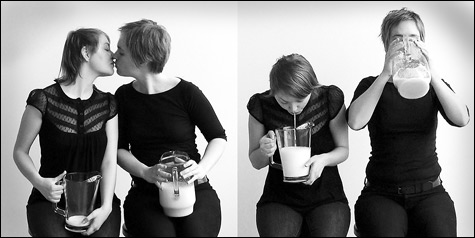
DETACHED INTIMACY: In Caitlin Berrigan’s video Transfer. |
Caitlin Berrigan’s 2009 video Transfer is simple and elemental. It is the quietest and least-involved piece in “Exchange,” a group show at the Institute of Contemporary Art at Maine College of Art, but it is also the most striking. The black-and-white video, projected onto a wall, is seemingly benign and straightforward: two women sit stoically before the camera, each holding a pitcher, one full of milk, and the other empty. For half an hour, the women silently pass the milk from the full pitcher to the empty one via their mouths. They perform methodically and unemotionally, in contrast to the intimacy of their action, which, despite its simplicity, seems offensive, or at least viscerally repelling. The milk, symbolic of life, nurture, and a reminder of our animal selves, is rendered useless, contaminated with saliva, a body fluid deemed un-consumable. The video sweetly confronts the viewer with her own assumptions and limitations concerning the body and its “gross” parts by presenting an awkward and otherwise inconceivable situation.
There is a meditative quality in Berrigan’s video, both in the repetitive nature of the performers’ action, and in the viewing of the protracted work. It is a quality shared by each of the works in “Exchange,” reflecting the focus and receptiveness required in successful collaborations and acceptance of new considerations. Deb Todd Wheeler invites visitors to collaborate in the completion of “PolyPolyphemous,” an installation workshop, to create a hooked rug made of contemporary detritus. A spectrum of plastic bag scraps forms a grid on two walls, surrounding a mat suspended from the ceiling, awaiting viewers to “hook as (they) so desire.” When finished, the eyes of a polyphemous moth will emerge in a ruffle of plastic knots. The installation is colorful and hodge-podge, an intervention encouraging re-imagining our own waste and work environments.
Painter Max Gimblett and poet Lewis Hyde have honed their collaboration over the last 20 years, jointly producing paintings on canvas, works on paper, and artist books. The works shown here, entitled “animal dreaming,” were created during a meeting at Gimblett’s New York studio in 2009. They are irreverent and explosive works meshing text, expressive painting, sculpture, and a muddle of common and lavish materials applied in an almost scatological manner. Reminiscent of the Norman Bluhm and Frank O’Hara collaborations recently on view at the Bowdoin Museum of Art, the artists improvise, though Hyde and Gimblett’s works also appear to be weighted by meditated decisions. Themes repeat in many of the paintings, including Hermes and his caduceus, fish, and Asian calligraphy. One wall of the gallery holds 44 drawings spanning from 1995 to 2010, illuminating how prolific the pair have been together, as well as imagery and ideas that were reworked over and over.